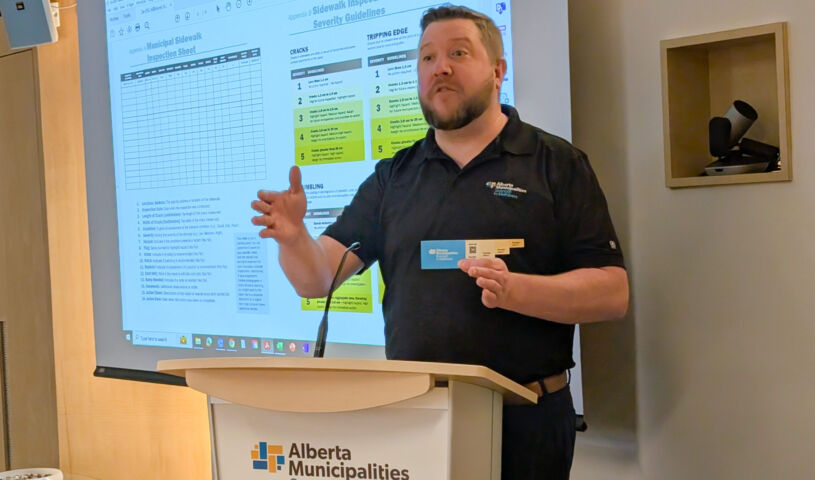Alberta Municipalities' personal approach to risk management
 Daniel Jackson is Alberta Municipalities’ Risk Services Manager. He has worked for Alberta Municipalities for nearly eight years and has more than 12 years’ experience in the field of insurance. Photo: Alberta Municipalities
Daniel Jackson is Alberta Municipalities’ Risk Services Manager. He has worked for Alberta Municipalities for nearly eight years and has more than 12 years’ experience in the field of insurance. Photo: Alberta Municipalities
Risk management is crucial for all municipalities, but smaller communities often lack the staff or funding to implement it effectively.
In Alberta, the organization that stands as the voice of municipalities works to take this problem off the hands of its members.
Daniel Jackson is manager of risk services with Alberta Municipalities. Alberta Municipalities has about 270 member communities, many of which are members of the association’s insurance reciprocal – Munix.
Jackson certainly knows how important risk management is for local governments. Risk management, he explained, is looking at the operations of a municipality and trying to do things as safely and as reasonably as possible.
“Safer communities are the ones where people are going to want to live and raise their families,” Jackson said. “(Risk management) is working within the financial constraints of running a municipality and understanding the budgetary constraints to keep the people in the community reasonably safe.”
New Way for Important Work
Jackson has an insurance background. Before working for Alberta Municipalities (where he has been for more than eight years), he has seen first-hand how a lot of times an insurance company would come in and say, “Thou shalt do this or not do this or else.” Or, put another way, Jackson describes it as a “my way or the highway” approach.
Non-compliance, Jackson said, may lead to penalties or even the loss of the municipality’s insurance coverage.
Alberta Municipalities does things differently. Jackson said the difference stems from understanding how municipalities operate while understanding that the “or else” approach is not always possible.
As such, Alberta Municipalities offers its members options in order to reach a compromise and do things to make risk management work for the municipalities.
“We identify the risks our member communities face and then give them the tools and guidance needed to improve their risk profiles,” Jackson said. “I take the approach an in-house risk manager would take. I’m focused on identifying their risks and then figuring out how to mitigate, reduce, or even eliminate them.”
Case Study Example
Alberta Municipalities offers a program working with a vendor where the organization basically handles loss control, facilities, or risk management inspections. They go in and focus on the high occupier liability risk buildings (recreation facilities, arenas, pools, etc.).
As an example, an inspector goes into an arena and explains there should be a railing going up these steps where the spectators sit. This recommendation is then made to the municipality.
But suppose it is a smaller municipality, or an older building, and the municipality doesn’t have the money to make the recommended changes. Under Jackson’s approach, the conversation changes to what is trying to be accomplished by the recommendation.
The situation is looked at from two angles. For one, the recommendation is being made to try and reduce the chance of somebody slipping and falling and hurting themselves. But it is also being made to ensure the municipality has some kind of defence should something go to the courts.
And so, if the municipality doesn’t have the funding to install the recommended railings, the suggestion shifts. Instead, it is recommended the municipality put up some warning signage or lay down some kind of anti-slip material on those steps.
“At least we’re addressing it. At least we’re doing something,” Jackson said. “We’re acknowledging that we know that the risk is there and they’re solving it the best they can with the resources they have available.”
Gentler Risk Management Approach
The approach undertaken by Alberta Municipalities, Jackson said, can be “quite consultative.” He can’t be everything to everybody of course, because if he were to go into each community, it would take him far more time than he has.
If they recognize an issue, he will arrange a call with those involved to discuss and understand the situation.
Perhaps he doesn’t have the knowledge and so would have to refer them to an expert such as a lawyer, an engineer, or some other subject matter expert. Alberta Municipalities has a lot of those, he said. But a lot of the time they’re able to get to the bottom of the problem and solve it.
“My primary goal is to help municipalities reduce the number of incidents and injuries that occur in their communities,” said Jackson, who recalled one municipal leader telling him that the community’s reputation is its stock value. “When a municipality is widely considered a safe and healthy place to live and work, then it’s easier to keep current employees and residents and attract new ones.”
Prepare for Risks Large and Small
There are numerous risks facing a municipality. But the most common, the “frequent flyers” as Jackson describes them, are trips and falls. If municipalities have a maintenance program for sidewalks, for example, the risk of tripping and falling decreases.
Odds are, Jackson said, if someone trips and falls, they could most likely break their wrist or suffer some sort of injury like that. So, from a purely insurance perspective, it’s not super high cost. But it is high frequency.
From a safety standpoint, if a community has a way to reduce that from happening, they will be better prepared for any future eventuality. The opposite end of the scale, however, is one Jackson said is essential for municipalities to keep an eye on.
Municipal officials must make sure things are safe in their recreation facilities. With swimming pools, ponds, and lakes, there’s always risk of drowning or somebody going without oxygen for a long time. Those can lead to the “really scary” scenarios.
And so, depending on the type of building, Jackson said the goal is to be able to help their members ensure they’re operating their facilities as safely as possible.
“It costs municipalities time and money whenever they open or close a claim, so we work hard to keep these costs as low as possible,” Jackson said. “If we can address the root cause and work with the municipality to address it, then we can reduce the frequency and cost of related insurance claims over time.” MW
✯ Municipal World Executive and Essentials Plus Members: You might also be interested in George Barnes’s article: Cemetery risk management crucial to reducing liability risk.
Sean Meyer is digital content editor for Municipal World.
Related resource materials:
- Public safety starts with smart procurement
- Are municipalities being lulled into a false sense of security?
- Collaboration for better municipal asset management



